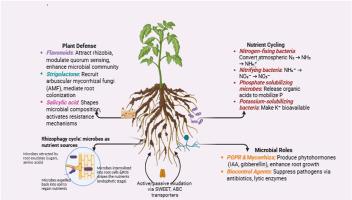The secret dialogue between plant roots and the soil microbiome: A hidden force shaping plant growth and development
IF 3.3
3区 农林科学
Q2 PLANT SCIENCES
引用次数: 0
Abstract
The rhizosphere is a dynamic ecosystem where plant roots interact with diverse microbial communities, including bacteria and fungi, through complex chemical signaling. These interactions are pivotal in promoting plant growth, nutrient cycling, and resilience to biotic and abiotic stresses. Plant root exudates—comprising sugars, amino acids, and secondary metabolites such as flavonoids, strigolactones, and salicylic acid—serve as substrates and signaling molecules, actively shaping microbial community structure and function. Mechanisms of exudation, including passive and active transport, highlight the specificity of plant-microbe interactions, influenced by environmental factors, growth stages, and stress conditions. These interactions foster symbiotic relationships with plant-growth-promoting rhizobacteria and mycorrhizal fungi, enhancing nutrient acquisition and disease suppression. The rhizosphere effect underscores the critical role of the root microbiome in improving soil health and plant productivity. Understanding these interactions lays the foundation for sustainable agriculture by reducing reliance on synthetic inputs and enhancing stress resilience.

植物根系与土壤微生物群之间的秘密对话:一种塑造植物生长和发育的隐藏力量
根际是一个动态的生态系统,植物根系通过复杂的化学信号与包括细菌和真菌在内的多种微生物群落相互作用。这些相互作用在促进植物生长、养分循环以及对生物和非生物胁迫的恢复能力方面是至关重要的。植物根系分泌物包括糖、氨基酸和次生代谢产物,如黄酮类化合物、独角糖内酯和水杨酸,它们作为底物和信号分子,积极塑造微生物群落的结构和功能。渗出的机制,包括被动和主动运输,强调了植物与微生物相互作用的特殊性,受环境因素、生长阶段和胁迫条件的影响。这些相互作用促进了与植物生长促进根细菌和菌根真菌的共生关系,增强了营养获取和疾病抑制。根际效应强调了根系微生物群在改善土壤健康和植物生产力方面的关键作用。通过减少对合成投入品的依赖和增强抗压力能力,了解这些相互作用为可持续农业奠定了基础。
本文章由计算机程序翻译,如有差异,请以英文原文为准。
求助全文
约1分钟内获得全文
求助全文
来源期刊
CiteScore
4.30
自引率
7.40%
发文量
130
审稿时长
38 days
期刊介绍:
Physiological and Molecular Plant Pathology provides an International forum for original research papers, reviews, and commentaries on all aspects of the molecular biology, biochemistry, physiology, histology and cytology, genetics and evolution of plant-microbe interactions.
Papers on all kinds of infective pathogen, including viruses, prokaryotes, fungi, and nematodes, as well as mutualistic organisms such as Rhizobium and mycorrhyzal fungi, are acceptable as long as they have a bearing on the interaction between pathogen and plant.

 求助内容:
求助内容: 应助结果提醒方式:
应助结果提醒方式:


